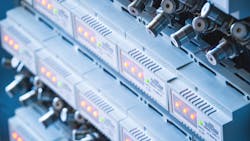Making Sense of the Industrial Sensors Market
What you’ll learn:
- Why are companies vying to have smart sensors in their manufacturing operations?
- What makes gas sensors so compelling?
- How will level sensors fare in the next five years?
With Industry 4.0 creating customer-focused solutions to surmount challenges, the industrial sensors market is forging ahead with new ideas and innovations to provide advanced solutions tailored to individual applications and catering to the future needs.
In an era where unprecedented demand for competitive and robust markets has made high-performance technologies indispensable to gain an edge, sensor solutions have underpinned power utilities, industrial machinery, semiconductor, telecom, oil and gas, and security equipment. Use of gas sensors, temperature sensors, control systems, automation, and robotics have become more prevalent than ever before to boost profitability, productivity, and efficiency in the industrial settings.
Sensors in industrial settings streamline pressure, flow, level, light, radiation, and acceleration, and often influence the safety, economic efficiency, and quality of the applications. In a bid to reduce cost and technology risks, smart sensors have come to the fore and are trending in the supply chain.
Smart Sensors Stimulate Innovation
Smart sensors are creating the digital last mile, bringing end-to-end visibility to customers, suppliers, and distributors. As leading players vie to propel operational efficiency, these sensors offer critical insights into customer behavior and help lower production costs.
Bolstered by automated monitoring processes such as predictive maintenance, inventory counts have played an invaluable role in enhancing performance accuracy and labor productivity. With the onboard technologies, including diagnostics, microprocessors, connectivity tools, and storage improving cost, profit, and volume analysis, investment in industrial sensors market has surged significantly.
Electrical and environmental smart sensors assess and identify disruptions or changes in magnetic or electrical signals, as well as examine changes in physical state, conditions, or surroundings of voltage, current, temperature, humidity, and color. Thus, they’ve become a natural fit to perform real-time inventory with enhanced demand planning and are sought after to reduce repair costs and maintenance downtime with better monitoring. Smart sensors give 360-degree view of all activities and help users receive advance notice of impending dangers.
A palpable shift to smart sensors has meant the intelligent sensors can streamline functions, including self-validate, self-test, self-identify, and self-adapt. They have the ability to manage a slew of conditions and support real-time decision-making.
Operational Efficiency from Gas Sensors
Investments in processing distributed sensor signals and manufacturing of embedded sensors have taken major strides in recent years. Demand is on the rise for sensors for real-time measurement and assessment to evaluate and monitor parameters such as gas composition and temperature pressure.
Countries such as the U.S. are spending billions of dollars to upgrade and maintain the grid against the backdrop of rigorous emission regulations and need for maintenance and reliability expectations.
Such sensors have the ability to influence transmission and distribution, integration of the bulk power system, and storage. In industrial settings, smart sensors for leakage monitoring and area monitoring are put in place to spot any gaseous accumulation. New sensors are being developed and expect innovations to ramp up over the next five years or so.
Oil-immersed power transformers are gaining traction as one of the most sought-after devices used in power systems. Here, gas sensors can spot faults in characteristic gases that may be dissolved in transformer oil and be used to assess the working state of transformers, thus helping to streamline operation of power grids.
Investment in sensors is helping companies boost productivity, minimize the total cost of ownership, and improve energy efficiency. And the evolution of sensing technology has brought greater sensitivity to data capture and real-time assessment with nearly lossless transmission.
Opportunities in Level and Chemical Sensors
Level sensors are gaining popularity as a way to detect the position of the surface within containers of liquids and solid materials in powder form. This gives manufacturers and distributors better monitoring capability when it comes to the amount of product in storage containers.
These sensors play a major role in fuel-level gauges for airplanes, cars, and boats. The same is true for petrochemical plants, as they help in the detection of acidic and highly corrosive substances.
A subset of level sensors gaining traction is the optical level sensor, which tracks several transparent sediments in the liquid. The flexibility in operating the sensor tends to high, thanks to the miniature appearance.
Chemical sensors also have become the linchpin for an array of environmental and industrial applications, such as quality control in the food, beverage, and medical applications. Such sensors detect and convert chemical information such as presence of a particular iron or element, composition, chemical activity, and concentration into a human readable signal.
With the expanding penetration of IoT, sensors will continue to remain the backbone of industrial settings. In the quest for the ideal sensing solution, gas sensors and level sensors may offer the high-accuracy results needed to achieve customer-specific solutions.
About the Author
Sunil Kumar Jha
Research Content Developer, Global Market Insights (GMI)
Sunil Jha has been a part of the content industry for close to two years. Having previously worked as a voice-over artist and sportswriter, he now focuses on penning down articles across numerous topics, ranging from business and technology to trade and finance. With a business-oriented educational background, Sunil brings forth the expertise of intensive research and a strategic approach in his pieces.
